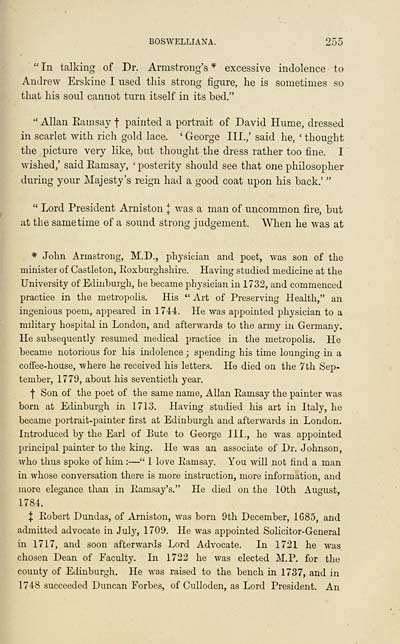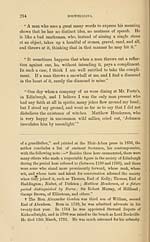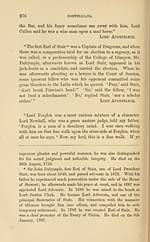Grampian Club > Boswelliana
(289) Page 255
Download files
Complete book:
Individual page:
Thumbnail gallery: Grid view | List view

BOSWELLIANA. 255
"In talking of Dr. Armstrong's* excessive indolence to
Andrew Erskine I used this strong figure, he is sometimes so
that his soul cannot turn itself in its bed."
" Allan Eainsay f painted a portrait of David Hume, dressed
in scarlet with rich gold lace. ' George III.,' said he, ' thought
the picture very Hke, but thought the dress rather too fine. I
wished,' said Ramsay, ' posterity should see that one philosopher
during your JNIajesty's reign had a good coat upon his back.' "
" Lord President Arniston | was a man of uncommon fire, but
at the same time of a sound strong judgement. When he was at
* John Armstrong, M.D., physician and poet, was son of the
minister of Castleton, Eoxburghshire. Having studied medicine at the
University of Edinburgh, he became physician in 1732, and commenced
practice in the metropolis. His " Art of Preserving Health," an
ingenious poem, appeared in 1 744. He was appointed physician to a
military hospital in London, and afterwards to the army in Germany.
He subsequently resumed medical practice in the metropolis. He
became notorious for his indolence ; spending his time lounging in a
coffee-house, where he received his letters. He died on the 7th Sep-
tember, 1779, about his seventieth year.
f Son of the poet of the same name, Allan Eamsay the painter was
born at Edinburgh in 1713. Having studied his art in Italy, he
became portrait-painter first at Edinburgh and afterwards in London.
Introduced by the Earl of Bute to George III., he was appointed
principal painter to the king. He was an associate of Dr. Johnson,
who thus spoke of him : — "' I love Eamsay. You will not find a man
in whose conversation there is more instruction, more information, and
more elegance than in Eamsay's." He died on the 10th August,
1784.
X Eobert Dundas, of Arniston, was born 9th December, 1685, and
admitted advocate in July, 1709. He was appointed Solicitor-General
in 1717, and soon afterwards Lord Advocate. In 1721 he was
chosen Dean of Faculty. In 1722 he was elected M.P. for the
county of Edinburgh. He was raised to the bench in 1737, and in
1748 succeeded Duncan Forbes, of Culloden, as Lord President. An
"In talking of Dr. Armstrong's* excessive indolence to
Andrew Erskine I used this strong figure, he is sometimes so
that his soul cannot turn itself in its bed."
" Allan Eainsay f painted a portrait of David Hume, dressed
in scarlet with rich gold lace. ' George III.,' said he, ' thought
the picture very Hke, but thought the dress rather too fine. I
wished,' said Ramsay, ' posterity should see that one philosopher
during your JNIajesty's reign had a good coat upon his back.' "
" Lord President Arniston | was a man of uncommon fire, but
at the same time of a sound strong judgement. When he was at
* John Armstrong, M.D., physician and poet, was son of the
minister of Castleton, Eoxburghshire. Having studied medicine at the
University of Edinburgh, he became physician in 1732, and commenced
practice in the metropolis. His " Art of Preserving Health," an
ingenious poem, appeared in 1 744. He was appointed physician to a
military hospital in London, and afterwards to the army in Germany.
He subsequently resumed medical practice in the metropolis. He
became notorious for his indolence ; spending his time lounging in a
coffee-house, where he received his letters. He died on the 7th Sep-
tember, 1779, about his seventieth year.
f Son of the poet of the same name, Allan Eamsay the painter was
born at Edinburgh in 1713. Having studied his art in Italy, he
became portrait-painter first at Edinburgh and afterwards in London.
Introduced by the Earl of Bute to George III., he was appointed
principal painter to the king. He was an associate of Dr. Johnson,
who thus spoke of him : — "' I love Eamsay. You will not find a man
in whose conversation there is more instruction, more information, and
more elegance than in Eamsay's." He died on the 10th August,
1784.
X Eobert Dundas, of Arniston, was born 9th December, 1685, and
admitted advocate in July, 1709. He was appointed Solicitor-General
in 1717, and soon afterwards Lord Advocate. In 1721 he was
chosen Dean of Faculty. In 1722 he was elected M.P. for the
county of Edinburgh. He was raised to the bench in 1737, and in
1748 succeeded Duncan Forbes, of Culloden, as Lord President. An
Set display mode to: Large image | Transcription
Images and transcriptions on this page, including medium image downloads, may be used under the Creative Commons Attribution 4.0 International Licence unless otherwise stated. ![]()
| Publications by Scottish clubs > Grampian Club > Boswelliana > (289) Page 255 |
|---|
| Permanent URL | https://digital.nls.uk/82554872 |
|---|
| Description | Note: Numbers 24-41 are relative to but not part of the Club's series. |
|---|---|

